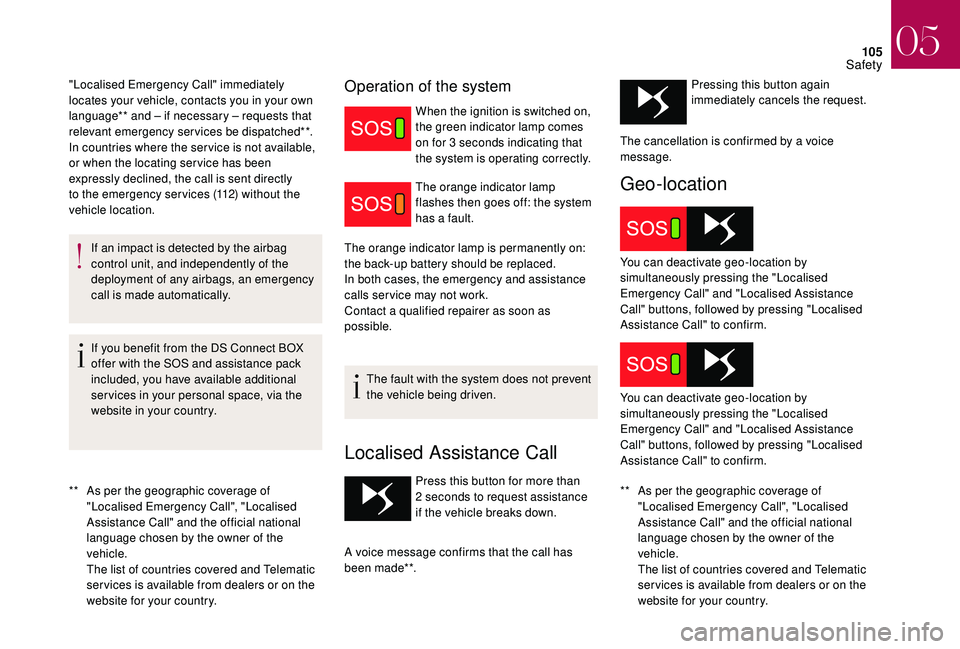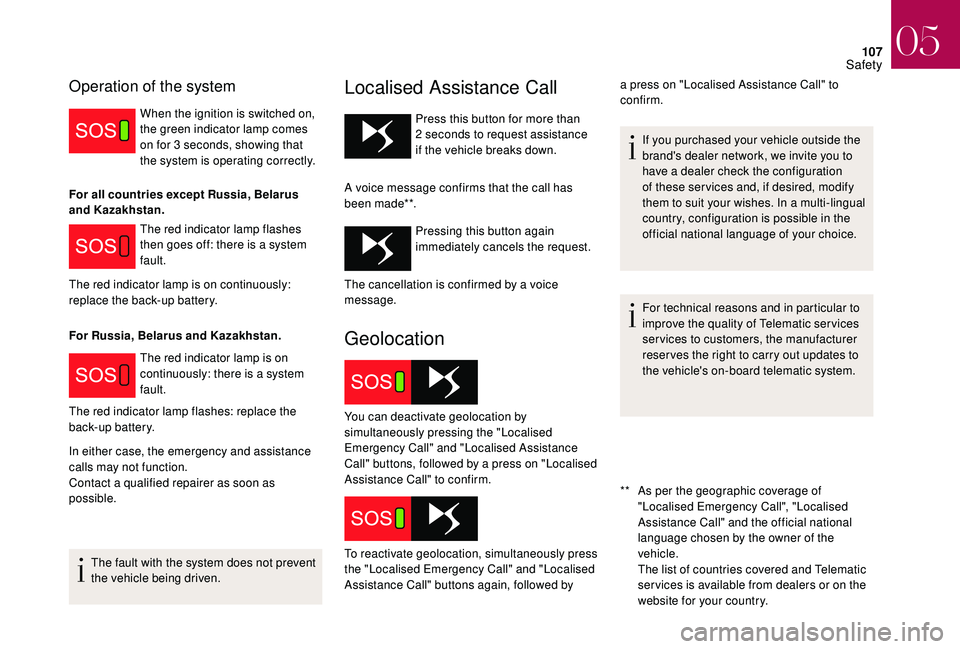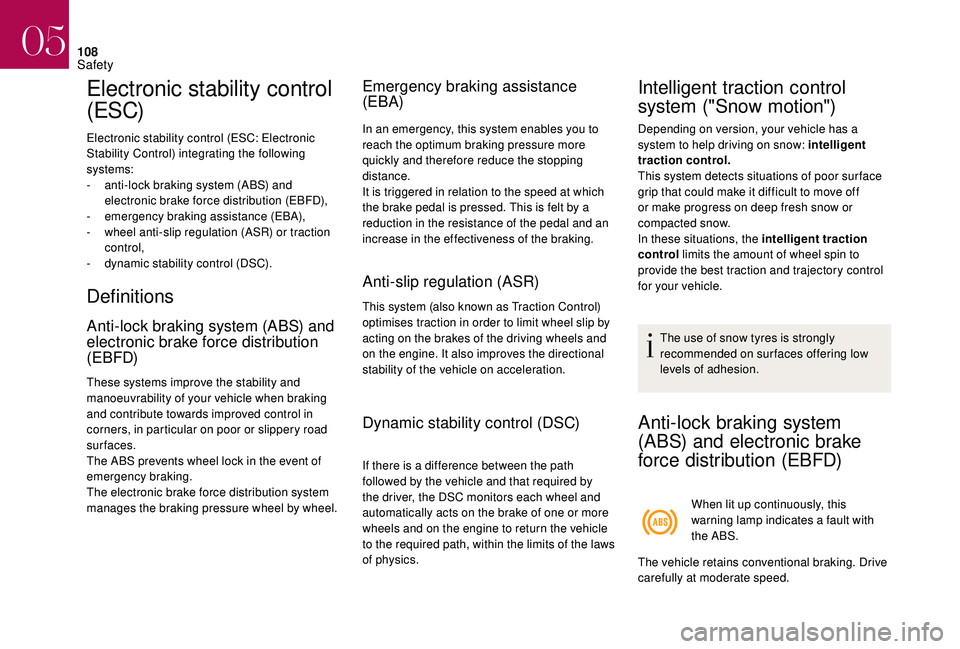CITROEN DS4 2023 Owners Manual
Manufacturer: CITROEN, Model Year: 2023, Model line: DS4, Model: CITROEN DS4 2023Pages: 296, PDF Size: 9.91 MB
Page 101 of 296

99
Without AUTO wiping
With AUTO wiping
Front wipers
To select wiping speed: raise or lower the lever
to the desired position.Fast wiping (heavy rain).
Normal wiping (moderate rain). Intermittent wiping (proportional to
the speed of the vehicle).
Of f.
Single wipe (press downwards or
pull the stalk briefly towards you,
then release).
or Automatic wiping (press down,
then release).
Single wipe (pull the stalk briefly
towards you).
Automatic windscreen wipers
The windscreen wipers operate automatically
once rainfall is detected (sensor behind the
rear view mirror), adapting their speed to the
intensity of the rainfall without any action on the
part of the driver.
Switching on
F Briefly push the control stalk downwards.
The request is confirmed by a wiping cycle,
accompanied by illumination of this warning
lamp in the instrument panel and/or display of
an activation message.
Switching off
Briefly push the stalk downwards
again.
The request is confirmed by this warning lamp
going off in the instrument panel and/or display
of a deactivation message.
The automatic windscreen wipers must
be reactivated each time the ignition has
been off for more than one minute.
04
Lighting and visibility
Page 102 of 296

100
Malfunction
If a fault occurs with the automatic rain sensitive
wipers, the wipers will operate in intermittent mode.
Contact the dealer network or a qualified workshop.
Do not cover the rain sensor, linked with
the sunshine sensor and located in the top
centre of the windscreen, behind the rear
view mirror.
When using an automatic car wash, switch
off the automatic rain sensitive wipers.
In winter, it is advisable to wait until the
windscreen is completely clear of ice before
activating the automatic rain sensitive wipers.
Windscreen and headlamp
wash
Front screenwashHeadlamp wash
To reduce the fluid consumption of the
headlamp wash, it operates only with
every seventh use of the screenwash or
every 25 miles (40 km) during a given
j o u r n ey.
Low screenwash/headlamp wash
fluid
level
Checking and topping up this fluid should be
done with the engine off.
The fluid level should be checked
regularly, particularly during winter.
For more information on Checking levels and,
in particular, the screenwash/headlamp wash,
refer to the corresponding section.
Special position of the
windscreen wipers
This position permits release of the windscreen
wiper blades.
It is used for cleaning or replacement of the
wiper blades. It can also be useful, in winter, to
release the wiper blades from the windscreen.
F
P
ull the windscreen wash control towards
you. The windscreen wash and then the
wipers come on for a preset time.
They operate by themselves when the dipped
and main beam headlamps are off or when the
vehicle is stationary. Associated with the screenwash, the headlamp
wash operates when the vehicle is moving and
the dipped or main beam headlamps are on
.
On vehicles fitted with headlamp washers, the
low level of this fluid is indicated by a gauge
located in the reser voir filler neck under the
bonnet. F
I
n the minute following ignition switch-off,
any operation of the wiper control stalk will
position the wiper blades vertically.
04
Lighting and visibility
Page 103 of 296

101
F To park the wiper blades again, switch on the ignition and operate the wiper stalk.
To maintain the effectiveness of the wiper
blades, it is advisable to:
-
h
andle them with care,
-
c
lean them regularly using soapy
water,
-
a
void using them to retain cardboard
on the windscreen,
-
r
eplace them at the first signs of wear.
Rear wiper
If a significant accumulation of snow or ice
is present, or when using a tailgate bicycle
carrier, deactivate the automatic rear
wiper via the vehicle configuration menu. Park.
Intermittent wipe.
Wash-wipe. Turn the ring fully; the
rear screen wash, then the rear
wiper automatically operate for a set
duration.
Reverse
When reverse gear is engaged, the rear wiper
will come into operation if the windscreen wiper
is operating.
Programming
The function is activated or
deactivated via the vehicle
configuration menu.
This function is activated by default.
04
Lighting and visibility
Page 104 of 296

SAFET Y
05
Page 105 of 296

103
General safety
recommendations
Labels are attached in different places on
your vehicle. They include safety warnings
as well as identification information for
your vehicle. Do not remove them: they
are an integral part of your vehicle.We draw your attention to the following
points:
-
T
he fitting of electrical equipment
or accessories not approved by DS
AUTOMOBILES may cause excessive
current consumption and faults and
failures with the electrical system
of your vehicle. Contact the dealer
network for information on the range of
recommended accessories.
-
A
s a safety measure, access to
the diagnostic socket, used for the
vehicle's electronic systems, is
reser ved strictly for the dealer network
or qualified workshops, equipped
with the special tools required (risk
of malfunctions of the vehicle's
electronic systems that could cause
breakdowns or serious accidents).
The manufacturer cannot be held
responsible if this advice is not
followed.
-
A
ny modification or adaptation
not intended or authorised by DS
AUTOMOBILES or carried out without
meeting the technical requirements
defined by the manufacturer will result
in the suspension of the legal and
contractual warranties. Installation of accessory radio
communication transmitters
Before installing a radio communication
transmitter with an external antenna,
you must contact a member of the
dealer network for the specification
of transmitters which can be fitted
(frequency, maximum power,
antenna position, specific installation
requirements), in line with the Vehicle
Electromagnetic Compatibility Directive
(2004/104/EC).
Depending on country regulations, some
safety equipment may be compulsory:
high visibility safety vests, warning
triangles, breathalysers, spare bulbs,
spare fuses, fire extinguisher, first aid kit,
mud flaps at the rear of the vehicle, etc.
05
Safety
Page 106 of 296

104
Hazard warning lamps
Visual warning by means of the direction
indicators to alert other road users to a vehicle
breakdown, towing or accident.
F
P
ress this button, the direction indicators
flash.
It can operate with the ignition off.
Automatic operation of hazard
warning lamps
When braking in an emergency, depending on
the deceleration, the hazard warning lamps
come on automatically.
They switch off automatically the first time you
accelerate.
F
Y
ou can also switch them off by pressing
the button.
Horn
Audible warning system to alert other road
users to an imminent danger.
F
P
ress the central part of the steering wheel
with the integrated controls.
Use the horn in moderation and only
in the circumstances allowed by traffic
regulations in the country in which you are
driving.
Emergency or assistance
call (type 1)
Localised Emergency Call
* In accordance with the general conditions of use for the ser vice available from dealers
and subject to technological and technical
limitations. In an emergency, press this
button for more than 2 seconds.
The flashing green LED and the voice message
confirm that the call has been made to the
"Localised Emergency Call" call centre*. Pressing this button again
immediately cancels the request.
The green LED goes off.
The green indicator lamp remains on (without
flashing) when communication is established.
It goes off at the end of the call.
05
Safety
Page 107 of 296

105
** As per the geographic coverage of "Localised Emergency Call", "Localised
Assistance Call" and the official national
language chosen by the owner of the
vehicle.
The list of countries covered and Telematic
ser vices is available from dealers or on the
website for your country.
"Localised Emergency Call" immediately
locates your vehicle, contacts you in your own
language** and – if necessary – requests that
relevant emergency services be dispatched**.
In countries where the ser vice is not available,
or when the locating ser vice has been
expressly declined, the call is sent directly
to the emergency services (112) without the
vehicle location.
If an impact is detected by the airbag
control unit, and independently of the
deployment of any airbags, an emergency
call is made automatically.
If you benefit from the DS Connect BOX
offer with the SOS and assistance pack
included, you have available additional
ser vices in your personal space, via the
website in your country.
Operation of the system
When the ignition is switched on,
the green indicator lamp comes
on for 3 seconds indicating that
the system is operating correctly.
The orange indicator lamp
flashes then goes off: the system
has a fault.
The orange indicator lamp is permanently on:
the back-up battery should be replaced.
In both cases, the emergency and assistance
calls ser vice may not work.
Contact a qualified repairer as soon as
possible.
The fault with the system does not prevent
the vehicle being driven.
Localised Assistance Call
** As per the geographic coverage of "Localised Emergency Call", "Localised
Assistance Call" and the official national
language chosen by the owner of the
vehicle.
The list of countries covered and Telematic
ser vices is available from dealers or on the
website for your country.
Press this button for more than
2
seconds to request assistance
if the vehicle breaks down.
A voice message confirms that the call has
been made**. Pressing this button again
immediately cancels the request.
Geo-location
The cancellation is confirmed by a voice
message.
You can deactivate geo-location by
simultaneously pressing the "Localised
Emergency Call" and "Localised Assistance
Call" buttons, followed by pressing "Localised
Assistance Call" to confirm.
You can deactivate geo-location by
simultaneously pressing the "Localised
Emergency Call" and "Localised Assistance
Call" buttons, followed by pressing "Localised
Assistance Call" to confirm.
05
Safety
Page 108 of 296

106
If you purchased your vehicle outside the
dealer network, we invite you to have a
dealer check the configuration of these
ser vices and, if desired, modify them to
suit your wishes.
In a multi-lingual country, configuration is
possible in the official national language
of your choice.
For technical reasons and in particular to
improve the quality of Telematic ser vices
services to customers, the manufacturer
reser ves the right to carry out updates to
the vehicle's on-board telematic system.
Emergency or assistance
call (type 2)
Localised Emergency Call
In an emergency, press this
button for more than 2 seconds.
The flashing green LED and
the voice message confirm that
the call has been made to the
"Localised Emergency Call" call
c e nt re*.
Pressing this button again
immediately cancels the call.
The green LED goes off.
The green LED remains on (without flashing)
when communication is established.
It goes off at the end of the call.
Localised Emergency Call immediately
locates your vehicle, contacts you in your own
language** and – if necessary – requests that
relevant emergency services be dispatched**.
In countries where the ser vice is not available,
or when the locating ser vice has been
expressly declined, the call is sent directly
to the emergency services (112) without the
vehicle location.
If an impact is detected by the airbag
control unit, and independently of the
deployment of any airbags, an emergency
call is made automatically. If you benefit from the DS Connect BOX
offer with the SOS and assistance pack
included, you have available additional
ser vices in your personal space, via the
website in your country.
*
I
n accordance with the general conditions
of use for the ser vice available from dealers
and subject to technological and technical
limitations.
**
A
s per the geographic coverage of
Localised Emergency Call, Localised
Assistance Call and the official national
language chosen by the owner of the
vehicle.
The list of countries covered and Telematic
ser vices is available from dealers or on the
website for your country.
05
Safety
Page 109 of 296

107
Operation of the system
When the ignition is switched on,
the green indicator lamp comes
on for 3 seconds, showing that
the system is operating correctly.
The red indicator lamp flashes
then goes off: there is a system
fault.
The red indicator lamp is on
continuously: there is a system
fault.
In either case, the emergency and assistance
calls may not function.
Contact a qualified repairer as soon as
possible.
The fault with the system does not prevent
the vehicle being driven.
Localised Assistance Call
** As per the geographic coverage of "Localised Emergency Call", "Localised
Assistance Call" and the official national
language chosen by the owner of the
vehicle.
The list of countries covered and Telematic
ser vices is available from dealers or on the
website for your country.
Press this button for more than
2
seconds to request assistance
if the vehicle breaks down.
A voice message confirms that the call has
been made**. Pressing this button again
immediately cancels the request.
Geolocation
For all countries except Russia, Belarus
and Kazakhstan.
The red indicator lamp is on continuously:
replace the back-up battery.
For Russia, Belarus and Kazakhstan.
The red indicator lamp flashes: replace the
back-up battery. If you purchased your vehicle outside the
brand's dealer network, we invite you to
have a dealer check the configuration
of these ser vices and, if desired, modify
them to suit your wishes. In a multi-lingual
country, configuration is possible in the
official national language of your choice.
For technical reasons and in particular to
improve the quality of Telematic ser vices
services to customers, the manufacturer
reser ves the right to carry out updates to
the vehicle's on-board telematic system.
The cancellation is confirmed by a voice
message.
You can deactivate geolocation by
simultaneously pressing the "Localised
Emergency Call" and "Localised Assistance
Call" buttons, followed by a press on "Localised
Assistance Call" to confirm.
To reactivate geolocation, simultaneously press
the "Localised Emergency Call" and "Localised
Assistance Call" buttons again, followed by a press on "Localised Assistance Call" to
confirm.
05
Safety
Page 110 of 296

108
Electronic stability control
(ESC)
Electronic stability control (ESC: Electronic
Stability Control) integrating the following
systems:
-
a
nti-lock braking system (ABS) and
electronic brake force distribution (EBFD),
-
em
ergency braking assistance (EBA),
-
w
heel anti-slip regulation (ASR) or traction
control,
-
d
ynamic stability control (DSC).
Definitions
Anti-lock braking system (ABS) and
electronic brake force distribution
(EBFD)
These systems improve the stability and
manoeuvrability of your vehicle when braking
and contribute towards improved control in
corners, in particular on poor or slippery road
surfaces.
The ABS prevents wheel lock in the event of
emergency braking.
The electronic brake force distribution system
manages the braking pressure wheel by wheel.
Emergency braking assistance
(EBA)
In an emergency, this system enables you to
reach the optimum braking pressure more
quickly and therefore reduce the stopping
distance.
It is triggered in relation to the speed at which
the brake pedal is pressed. This is felt by a
reduction in the resistance of the pedal and an
increase in the effectiveness of the braking.
Anti-slip regulation (ASR)
This system (also known as Traction Control)
optimises traction in order to limit wheel slip by
acting on the brakes of the driving wheels and
on the engine. It also improves the directional
stability of the vehicle on acceleration.
Dynamic stability control (DSC)
If there is a difference between the path
followed by the vehicle and that required by
the driver, the DSC monitors each wheel and
automatically acts on the brake of one or more
wheels and on the engine to return the vehicle
to the required path, within the limits of the laws
of physics.
Intelligent traction control
system ("Snow motion")
Depending on version, your vehicle has a
system to help driving on snow: intelligent
traction control.
This system detects situations of poor sur face
grip that could make it difficult to move off
or make progress on deep fresh snow or
compacted snow.
In these situations, the intelligent traction
control limits the amount of wheel spin to
provide the best traction and trajectory control
for your vehicle.
The use of snow tyres is strongly
recommended on sur faces offering low
levels of adhesion.
Anti-lock braking system
(ABS) and electronic brake
force distribution (EBFD)
When lit up continuously, this
warning lamp indicates a fault with
the ABS.
The vehicle retains conventional braking. Drive
carefully at moderate speed.
05
Safety